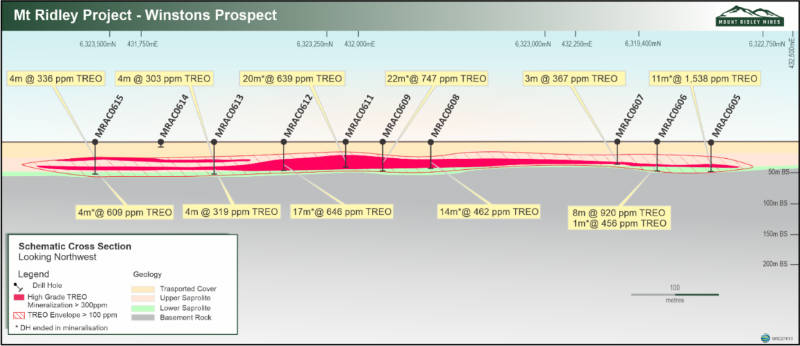Ionic clay rare earths are Mount Ridley’s key to the big leagues

Pic: Bloomberg Creative / Bloomberg Creative Photos via Getty Images
Rare earths are in high demand, so Mount Ridley Mines has plenty of good reason to get excited after identifying laterally extensive deposits at its namesake project.
A recent re-assay of 950 aircore samples returned significant rare earth element values – including 20 over 1,000 parts per million total rare earth oxides (TREO) – over an apparent strike of more than 25km that remains open in all directions.
While that alone would be enough to get anyone’s interest, it’s the nature of the rare earths mineralisation that might well be of greatest interest.
Quite simply put, Mount Ridley Mines (ASX:MRD) has uncovered what appears to be rare earth elements hosted in ionic adsorption clay (IAC), and that is potentially very exciting indeed.
To put a little context to this, we need to examine what makes IAC deposits tick.
IAC deposits are typically found in southern China and are commonly considered to be some of the cheapest and most readily accessible sources of heavy rare earths, as well as making up a significant percentage of the world’s total output.
For a long time, the only significant deposit outside of China has been Ionic Rare Earth’s (ASX:IXR) Makuutu project in Uganda, which has been responsible for Ionic’s market capitalisation growth since the beginning of this year.
That is until now.
While Mount Ridley’s project is still at an early stage, the results to date already compare favourably to Makuutu and could well represent the opening of a new IAC-hosted rare earths play outside of China and Uganda.
A fortuitous discovery
Here’s the thing – the Mount Ridley project wasn’t originally pegged for its rare earths potential. It was identified for nickel and copper sulphides and the company had started looking for opportunities that would allow it to gain exposure to clean energy and green economy space, company secretary Peter Christie told Stockhead.
As luck would have it, one of the company’s consultants indicated to the company that the project had the hallmarks of hosting rare earths.
“It was a very simple process for us to rerun some samples and the results of those samples which confirmed the presence of significant rare earths,” he noted.
The simple processing required for IAC deposits has drawn investors to companies with such projects as can be seen by recent gains by new listee Australian Rare Earths (ASX:AR3) while Ionic has as previously noted significant upward gains past the $115m mark for market capitalisation.
“The value proposition for Mount Ridley is that if we can demonstrate that we have a lot of tonnes and that it is metallurgically similar to Makuutu, then we will be in a pretty interesting space,” Christie said.
The first goal is not likely to be hard given the presence of strongly mineralised intervals over a 25km strike that’s over 1km wide, which Busing described as being like a river that runs through the company’s tenements.
“Tonnes isn’t going to be the issue, it’s all going to be about efficient metallurgy and that’s where we will be also putting our time,” he added.
“Then we come back to logistics; mining operations live and die by logistics.”
Here’s where the project’s location just 30km from Esperance comes into play.
While the region where the Mt Ridley project sits remains underexplored, its proximity to a major deep-water port means that it is close to infrastructure and amenities.

Upcoming activity
Looking ahead, the company is waiting for the re-assay results for the remaining 160 samples.
“We have a geochemist who will help us map the profiles, understand what rocks we are in and understand where we are in the clay profile,” Christie noted.
“And then we will also kick off the metallurgy and once we do that, we are going to see which of the elements are going to come out easily and which are harder. Then we can tailor our exploration process accordingly.”
On metallurgy, he noted that the company wanted to see more dysprosium and terbium heavy rare earths and the highly-valued critical rare earths neodymium and praseodymium (NdPr).
“I think we are alright with the NdPr. We were surprised to see how high our Dy and Tb were but we need to do more work on that,” Christie added.
To establish resources, Mount Ridley will carry out aircore drilling along with sonic drilling to establish the ore styles and what the metals are.
“That supplies us with density information and samples for metallurgy, so we will be working to convert what is basically an idea now, initially into an exploration target and then into inferred resources,” he explained.
“We will be drilling out from that strip that we know about up to about a 10km radius around that to give ourselves a global resource.”
Christie added that similarity with Makuutu mineralisation meant that a lot of the pioneering work had already been done for the company.
“It’s going to be a great starting point.”
This article was developed in collaboration with Mount Ridley Mines, a Stockhead advertiser at the time of publishing.
This article does not constitute financial product advice. You should consider obtaining independent advice before making any financial decisions.
Related Topics

UNLOCK INSIGHTS
Discover the untold stories of emerging ASX stocks.
Daily news and expert analysis, it's free to subscribe.
By proceeding, you confirm you understand that we handle personal information in accordance with our Privacy Policy.








